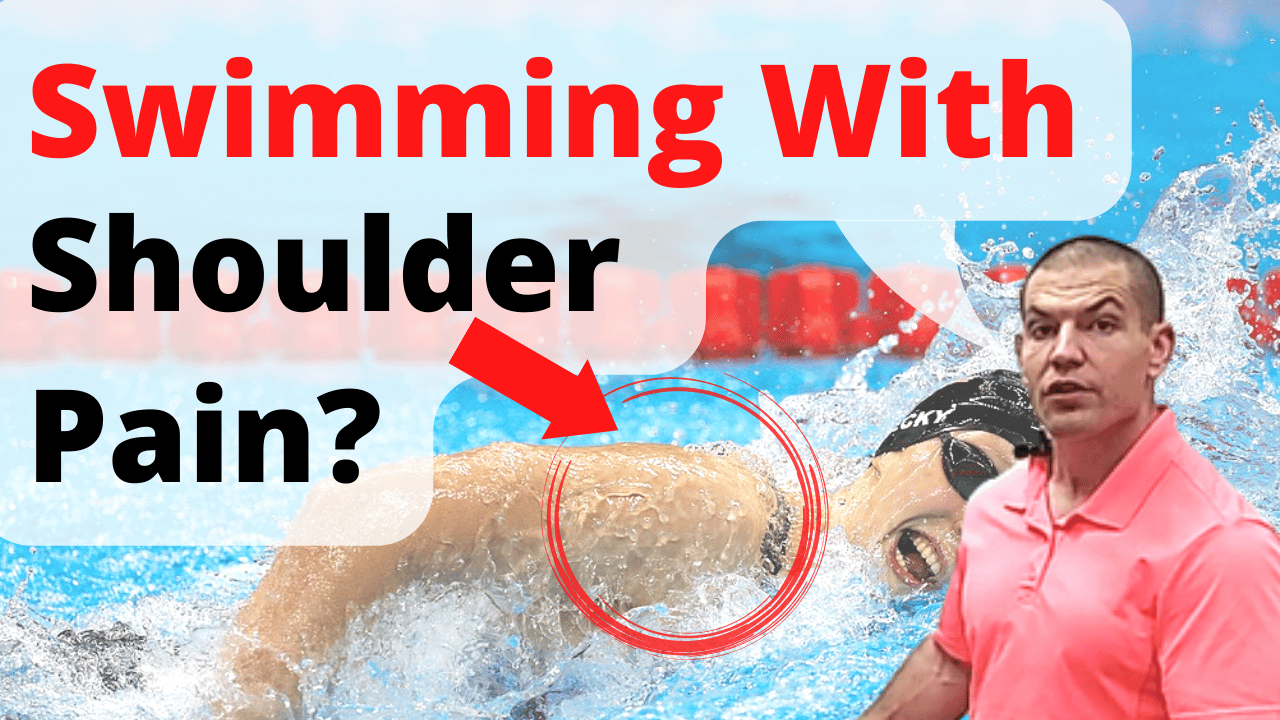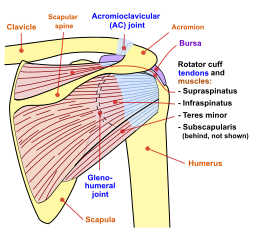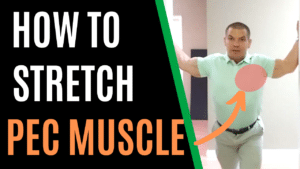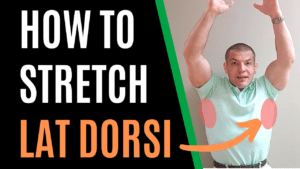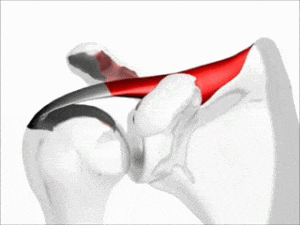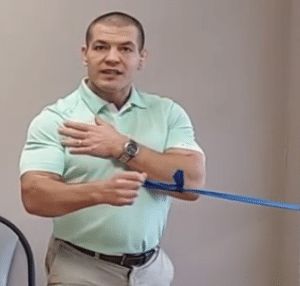Tired Of Swimming With Shoulder Pain?
Watch the video to learn what causes shoulder pain swimming plus easy tips swim without shoulder pain.

What Causes Shoulder Pain Swimming?
Swimming is an overhead sport for most strokes except for breast stroke.
Since you have to raise your arms in an overhead position repeatedly when swimming, it puts you at risk for pinching the rotator cuff tendons between the ball of the shoulder and the arch that runs over top of the shoulder (the coracoacromial arch).
This is particularly true if you have muscle imbalances in your chest and lat muscles that cause your shoulder blades to tip forward. When the shoulder blade tips forward, it lowers the arch of bone on the shoulder blade down into the rotator cuff tendons.
Which Swimming Strokes Are Best (And Worst) When Swimming With Shoulder Pain?
Easiest: Breaststroke
As you might imagine, breaststroke is the easiest stroke for someone who has shoulder pain because it's the only stroke where your arm never gets fully overhead.
Therefore, if you have shoulder pain and you'd like to get back to swimming right away, starting with breaststroke may be your fastest route back in the pool.
Most Difficult: Butterfly
Contrarily, butterfly is the most difficult stroke for someone with shoulder pain because you can't rotate your body during the stroke. Butterfly requires the most extreme range of motion out of your shoulders.
People who swim butterfly are also at highest risk of developing chest and lat muscle stiffness due to the muscle actions used when swimming butterfly.
Freestyle and Backstroke
Freestyle and backstroke are roughly equal in terms of their likelihood to cause shoulder pain.
Freestyle and backstroke use essentially the same range of motion of the shoulders, just in reverse. Therefore, the muscle imbalances that are likely to develop with freestyle and backstroke are different.
One easy way to prevent muscle imbalances if you primarily swim freestyle or backstroke is to mix it up and swim the other stroke as well. By using the muscles in the opposite pattern that you normally use, you can prevent overuse injuries and muscle imbalances.
What Muscle Imbalance Cause Shoulder Pain Swimming?
Stiffness in the chest and latissimus dorsi muscles are the most common muscle imbalances in swimmers.
An imbalance between the rotator cuff and shoulder (deltoid) muscles can also occur in swimmers as well as an imbalance between the front and back rotator cuff muscles (there are 4 of them)
What Help Shoulder Pain Swimming?
Exercises that focus on preventing the muscle imbalance listed above can help prevent shoulder pain swimming.
Shoulder Pain Swimming Exercises
- Chest (Pectoral) Stretches
- Latissimus Dorsi ("Lat") Stretches
- Rotator Cuff Strengthening Exercises
Chest (Pectoral Stretches)
As noted above, your chest muscles can cause your shoulder blades to tip forward, pulling the arch over the top of the shoulder down closer to the ball of the shoulder. This can pinch the rotator cuff tendons and cause shoulder pain swimming.
The chest muscles get strong and overdeveloped in many swimmers, particularly people who swim butterfly and freestyle. During these strokes, you use your chest muscles to "pull" the water right after your hand catches the water through the mid-pull of your stroke.
After that point the lat muscles take over.
To stretch your chest muscles you want to have your arms out to the side at or above shoulder level with your arm externally rotated.
Learn how to stretch your chest (pectoral) muscles in our post "How To Stretch Pec Minor and Pec Major Muscle"
Latissimus Dorsi ("Lat") Stretches
Like your chest muscles, your latissimus dorsi (or "lat") muscles are involved in pulling the water when when swimming breast stroke and freestyle.
Unlike the chest muscles that are only used in the first part of the pull, your lats remain active throughout the entire power phase - from the time your arm enters the water to the time it leaves the water.
The function of the lats is to pull your arm from an overhead position down to your side while also internally rotating the arm.
Therefore, in order to stretch the lats, you do just the opposite:
Elevate your arms with your elbows in front of your body and your arms arms externally rotated.
Click here to learn how to stretch your Latissimus Dorsi Muscle
Rotator Cuff Strengthening Exercises For Swimmers
As you can imagine, you rotate your arms a lot during swimming.
The rotator cuff muscles do have some function in rotating your arm, but their primary goal is to help keep the ball of your shoulder centered in the socket.
Your shoulder is a ball-and-socket joint. However, the ball isn't a perfectly round ball.
The ball has bumps on it, and when you raise your arm above your head as you do when swimming, the ball of the shoulder has a tendency to ride move upward in the socket, putting you at risk for pinching the rotator cuff tendons.
The job of the rotator cuff muscles is to keep the ball of the shoulder centered in the socket and prevent it from moving upward as you raise your arm overhead.
In order to strengthen the rotator cuff muscles, you can do exercise band exercises that are common in many physical therapy clinics.
These exercises DO strengthen the rotator cuff muscles, but primarily in their role as prime movers to rotate the arm.
To strengthen the rotator cuff muscles as as stabilizing muscles - the way you use them during swimming and other overhead activities, you need to train them in that manner.
Click here to learn other ways to strengthen your rotator cuff muscles.
Rotator Cuff Stretches For Swimmers
You can also develop muscle imbalances between the front and back parts of the rotator cuff muscles when swimming.
The pectoral is major and the latissimus dorsi muscles - the two power muscles during swimming - both attach to the front part of the ball of the shoulder and pull the ball forward, as well as into an internally rotated position. (Internal rotation means your arms twist toward the midline of your body.)
To counteract that force, the 3 rotator cuff muscles in the back of your shoulder have to work hard to pull the ball of the shoulder backwards and prevent excessive internal rotation of the arm.
This can cause the 3 posterior rotator cuff muscles (supraspinatus, infraspinatus, teres minor) as well as the posterior (back) capsule of the shoulder to get stiff.
Fortunately, there's a stretch for the posterior capsule of your shoulder called the Sleeper Stretch that is very effective for swimmers and other people with shoulder pain.
However, MOST people do the sleeper stretch less than optimally, or in some cases flat out WRONG.
Click here to learn how to do the sleeper stretch correctly
Stroke Mechanics To Prevent A Shoulder Injury From Swimming
Simply making some changes to the way you swim can prevent a shoulder injury from swimming. I'll discuss stroke mechanics for freestyle, backstroke, and butterfly below.
Please note: If you're a competitive swimmer, changing your stroke mechanics can affect your performance when you're first learning, so make sure to discuss these tips with your swim coach. Ideally you don't want to change your stroke right before a big swim meet.
Prevent Shoulder Pain Swimming Freestyle
The time you're most likely to injury your shoulder during freestyle is from the time your arm leaves the water to the time it enters the water.
During this part of your stroke, you're moving the arm from behind the body to an overhead position.
This is an un-natural movement of the shoulder during everyday life.
Using Body Roll When Swimming Freestyle
If you just do this part of your stroke using your arm, your elbow goes behind your body (shoulder extension). This movement pushes the ball of the shoulder forward in the socket while tipping the shoulder blade forward.
Both of these things can cause you to pinch your rotator cuff tendons.
If you get enough body roll, the arm-behind-body movement essentially gets translated into arm out to the side position (shoulder abduction). As a result, the ball of your shoulder is not as likely to pop forward in the socket and you're not as likely to injure your rotator cuff.
Shoulder External Rotation Swimming Freestyle
You also need to get enough external rotation of your arm as you're raising it overhead, even if you've got enough body roll.
There's a "bump" on the ball of the shoulder called the greater tuberosity, to which many of the rotator cuff tendons attach.
With your arm internally rotated, that ball can't slide under the arch of the shoulder as easily and you're more likely to pinch your rotator cuff.
If you roll your body, allow your shoulder blade to move backward, and externally rotate your arm, you'll clear the greater tuberosity out from under the arch of the shoulder and can prevent shoulder pain swimming freestyle.
If that doesn't make sense in written form, make sure you watch the video at the top of this page for a better visual explanation.
Prevent Shoulder Pain Swimming Backstroke
It's like freestyle, but backwards
During backstroke, you're also most likely to injury your shoulder from the time your arm leaves the water from the time it enters the water.
However, unlike freestyle, your arm is in front of your body during the part of the stroke when you're swimming backstroke.
Yep, still roll your body
Much like freestyle, if you only do your stroke with your arms, it requires an excessive, abnormal range of motion from your shoulder joint.
However, if you roll your body to the side away from the arm leaving the water so that your arm raises up over top of of your body instead of out to the side, it puts your shoulder in a more natural position.
Then as once you get your arm fully overhead, roll your body back toward the arm as you reach back toward the water.
This allows you to use your body to gain range of motion rather than creating hypermobility (excessive mobility) in your shoulder.
And don't forget the external rotation
Additionally, the rotation of your arm matters when swimming backstroke as well.
You need to use your little finger to "cut through" the water as your hand enters the water.
However, if you raise your arm overhead leading with your little finger, it puts your arm in an internally rotated position where you're likely to pinch the rotator cuff tendons.
Instead, lead with your thumb as you bring your arm out of the water and overhead, and then twist the arm at the last moment before entering the water so that your little finger enters the water first.
Just as described above for swimming freestyle, this puts your arm in an externally rotated position where the bump on your shoulder moves out from under the arch.
Again, if this doesn't fully make sense, make sure to watch the video at the top of this page for a better visual explanation.
Prevent Shoulder Pain Swimming Butterfly
As mentioned previously, butterfly is by far the most difficult stroke for someone swimming with shoulder pain.
You can't roll your body like you can with freestyle and butterfly, and it requires powerful contraction of your chest and lat muscles.
That means your chest and lat muscle have to be both strong and flexible, which often work at odds with each other.
The best butterfly swimmers often have strong but stiff chest and lat muscles, which give them a competitive advantage, but also put them at risk for shoulder injury.
Therefore, if you want to swim butterfly, it's important to stretch your chest muscles.
It's also important to squeeze your shoulder blades back together as your arms exit the water and rotate your shoulder blades and arms together as a unit as you move your arms overhead and into the water.
Of note though, swimming butterfly isn't great for your shoulders.
If you're not a competitive swimmer it may be best to stick to swimming freestyle, backstroke, and breaststroke, especially if you have shoulder pain.
Need Help For Shoulder Pain?
Tapt the button below to request an appointment with one of our specialists

